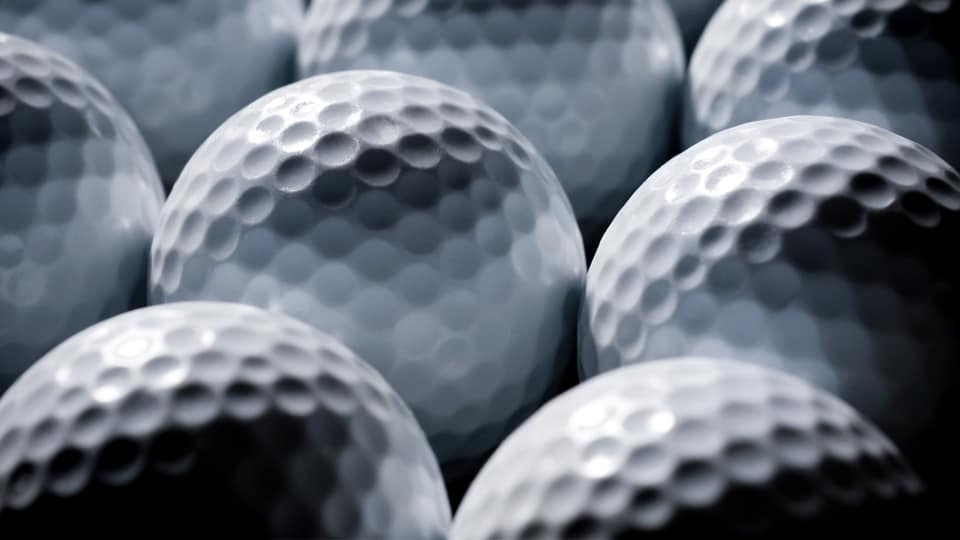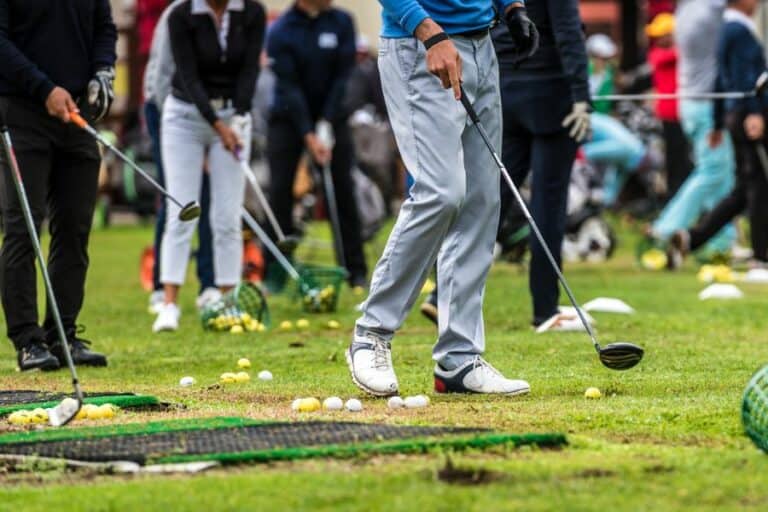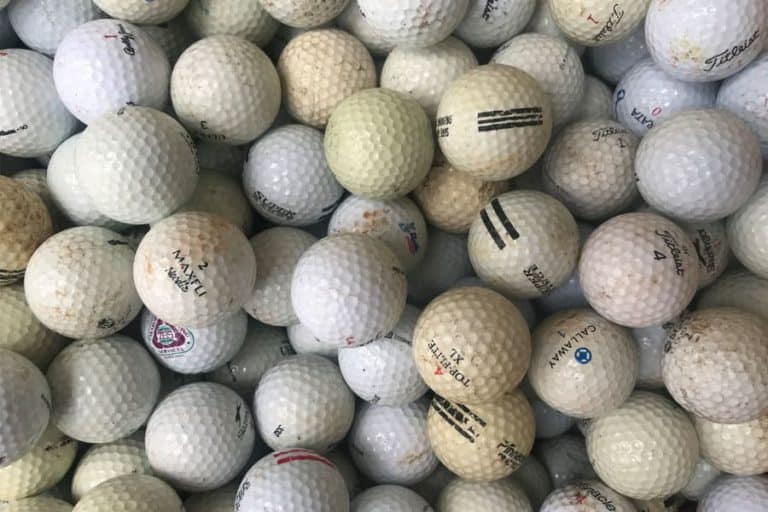How Many Dimples Are On a Golf Ball? (The Science Explained)

Golf is a sport of precision and accuracy. But have you ever wondered why does the golf ball consist of small depressions all over it known as dimples? This article explains how many dimples are on a golf ball and why they are there. Keep reading!
A golf ball features the aerodynamic package of dimples over it, which helps it travel further and perform better.
But, the most commonly asked questions by many golfers are how many dimples are on a golf ball, why are they necessary? Did the first golf ball invention also have dimples on it? If not, how did golf balls get dimples?
We have gathered a lot of information with intense research on this topic so that you get a better understanding of dimples on a golf ball.
I. How many dimples are on a Golf Ball?
Most commonly, the number of dimples on a golf ball ranges from 300 to 500. There are no official rules regarding how many dimples need to be present on a golf ball. But, on average, a good-performing golf ball needs to have at least 300 dimples on it, or the common dimples count is 336. A smooth golf ball hit by a golf club travels only half of the distance covered by dimpled golf balls.
Golf balls often have numbers printed on to them that tell you the number of dimples they have.
II. Why do golf balls have 336 dimples?
The golf ball dimple reduces the pressure on the golf ball by redirecting more air pressure toward the ball. Higher pressure forces the ball into long range.
However, there are some exceptions in which the balls have dimples beyond 400 or even 500+. One such example is Mizuno RB 566 and RB 566 V. They have got these names based on their aerodynamic design that includes 566 “micro-dimples.” This doesn’t mean that any expensive ball can let you stand out on the golf course, but its aerodynamic feature does.
Therefore, dimples on a golf ball are an important feature when it comes to evaluating a golf ball’s performance. But what are actually dimples, and why are they so necessary?
III. What are dimples?
If you have been playing golf, you would have noticed depressions all over the surface of the cover. These depressions on a golf ball are known as Dimples.
Dimples are sometimes spherical, hexagonal, or tetrahedral in design based on the branded golf ball type and style.
Moreover, the standard golf ball must be symmetrical and not contain unusual construction features.
Let’s answer some basic questions about the golf ball and its features:
How much does a golf ball weigh?
Golf ball weights have evolved over the years. In modern times, golf balls are forbidden to have a weight exceeding 1.620 ounces or 45.93 gm (no minimum weight).
How big is a golf ball supposed to be?
Golf balls must have a diameter that surpasses 1.680 inches or 42.67 mm. Interestingly, golf balls do not have a maximum required size.
How fast do golf balls travel?
How fast a golf ball travels depends on its adherence to specific measurements of distance and velocity capabilities throughout the trials. They can’t go faster than 255 feet per second / when hit by the USGA’s impact machine, the golf balls can’t go farther than 317 yards with 120 mph.
IV. History Of Golf Ball Dimples
The very first golf balls can be easily recognized in modern terms. The game began in Scotland in the 15th century.

The golf balls they played with were made from leather with boiling goose feathers splattered into their outer skin. The method used to make the ball was very effective.
In 1845 golf ball manufacturers began to manufacture sapodilla trees from Malaysia. They are commonly called “gutties” or ” gutta-percha ” golf balls. They travel much faster than a leather golf ball would have traveled.
With time, golfers learned that some balls used were farther away than fresh, smooth balls.
V. How Did Golf Balls Get Dimples?
In the 1800s, the first golf ball with a smooth surface was introduced due to an accidental invention.
However, earlier golfers used smooth balls for playing Golf and found that the more they used the golf ball, the further it went. This means they realized that slices and roughness over the cover make it go further.
Therefore, in 1905, Willam Taylor designed and manufactured the first dimpled golf ball in Leicester. Providing the biggest technological discovery in the history of Golf. He had filed a patent for the golf ball dimple design on 11 Sep 1906.
Later on, as technology and science developed, golf ball construction evolved. People redesigned and recreated various shapes and designs on the golf ball cover. They use computers and machines to produce dimples on the mold. Each golf ball is designed to be a simple design to deliver distance and greenside control for all level golfers.
VI. Different Dimple Patterns
Most dimples on a golf ball are symmetric, but not all. Typically these also follow a pattern where there are shallow dents followed by deeper dimples along ball surfaces. Many manufacturers of golf balls modify their interior characteristics before changing their dimple pattern.
Several years back, Callaway golf balls were introduced which had hexagonal shaped dimples. It became very popular. The dimple shape is argued to influence golf ball performances in certain ways.
VII. How Big Are Dimples on Golf Balls?
Golf ball dimples are small indentations on the surface of the ball. They are usually 0.010 inches (0.254 mm) deep and 0.12 inches (3.05 mm) in diameter.

These dimples play a crucial role in the flight of the ball by creating turbulence in the boundary layer of air surrounding the ball and reducing air resistance.
VIII. How Do Golf Dimples Work?
Golf ball’s performance characteristics are important to consider. If we go in-depth into dimples on a golf ball, we find that the golf ball dimples may look to be there on the cover just for decoration purposes, but in fact, they have a specific aerodynamic purpose. Aerodynamics is a branch of science that deals with how objects move through the air.
So, how do golf ball dimples work?
When you hit the golf ball, you provide it with the initial momentum. Therefore, the front part of the ball moves along the flight path toward the hole, and the ball pushes through the air, creating wind resistance.
This resistance then pushes the ball back by applying drag (a force that causes a moving object to slow) against it. So, if the ball had no spin, then it would not have gone further, but golf balls commonly have a backspin. Due to the backspin, the air moving over the top of the ball moves faster when compared to the ball.
Therefore, if the air moves faster, it exerts less pressure on the ball, and this effect in physics is known as Bernoulli’s principle. The lower-pressure air above the ball helps it to generate lift (the force that pushes the ball upwards) which helps it in traveling farther. The two forces – lift and drag, are responsible for how high, and far a golf ball goes.
Moreover, golf balls are unique not just because of their size but also because of the small impressions or dimples on their cover surface. As Steve Quintavella, USGA Equipment Standards Operation Manager said, “dimples are crucial to a golf ball’s flight and reduce aerodynamic drag or wind resistance to help it travel further.”
IX. Why Do Golf Balls Have Dimples?
Dimples on golf balls serve more than just entertainment. This is purely scientific. A dimple is a small, convex indentation on golf balls that’s about 10 inches long. Like any other damage or scratch on sporting equipment, golf ball dimples serve specific purposes.
When your golf ball lands in the air, the dimples reduce air resistance. It also decreases drag & improves ball performance. The turbulence is similar in appearance to Ping golf courses now. Dimples of golf balls create turbulence in the air which attaches to their underlying surfaces.
As we know, the cover of the ball consists of dents which are imperfections that create turbulence in the airflow around the moving ball, making the air behind the ball thinner and reducing drag. Moreover, they also increase the spin. As the ball moves forward through the air, the dimples cause the ball to actually spin backward by pulling the airflow downwards.
So, when this happens, the air at the bottom of the ball pushes up against the ball, which ultimately creates more lift. This statement is proven correct by Newton’s third law – that is, for every action, there is an equal and opposite reaction.
Therefore, even if dimples are small in design, they have a big impact.
X. Other Considerations
There are many factors in determining a game. Its smoothness and distance of travel depend on many more important factors, such as: How much movement and lifting the ball has, the drag and resistance ,or how the weather is?
Windy days are always difficult to golf in certain instances. Even though these forces may reduce the force and resistance of air around a ball, any golf ball may experience this effect even though it is less powerful than a normal ball.
XI. What Would Happen If Golf Balls Didn’t Have Dimples?

A smooth golf ball lacks elasticity and distance. With no optimized dimple airflow, the smoother golf balls tend to fly low, rotate wildly, and lack spin completely. A ball with a small dimple has some power.
Air moves more quickly over the ball and produces lower pressure, which makes them fly. The dimples produce lower drag which creates smooth, clear paths and smooth spin. Similarly, even one of the most smooth golfing balls could travel half the distance of an average dimpled ball. These dimples play an important role in playing golf.
XII. How Many Dimples Are On The Pros’ Golf Balls?
As we have established, there is a vast range of golf ball products available. Modern golf balls have several size dimples. The American golf ball in 2020 was designed to be 322 and to a max of 378 dimples.
Moreover, professional-use golf balls are a particular range. Professionals prefer a particular ball type with specialized dimples. It’s logical because these balls can be controlled easier.
XIII. Which Golf Balls Have the Most Dimples?
Golf balls are designed with dimples to improve their flight performance and distance. The number and pattern of dimples can vary between brands and models. Here is a comparison of some popular golf ball brands and their dimple count:
| Brand | Model | Dimple Count |
| Titleist | Pro V1 | dimple pattern of 392 |
| Callaway | Chrome Soft | dimple pattern of 328 |
| TaylorMade | TP5 | dimple pattern of 342 |
| Bridgestone | B330 | dimple pattern of 328 |
| Srixon | Z-Star | dimple pattern of 328 |
Conclusion
Overall, as golf lovers, we all should be thankful for the dimple invention on the golf ball surface, which helps to have more flight control and lift our shots more easily.
Moreover, if you are counting, most regulation golf balls will fall into the 300 to 450 dimple range. If you are measuring, your typical dent is about 7/1000th of an inch deep. Engineers say every 1/1000th is worth about five yards on the course.
So, now you know how many dimples are on a golf ball and why they are necessary.








